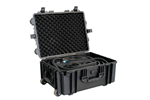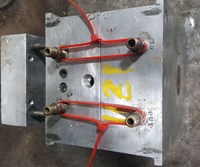Pushing the Limits of 3D Printing
Crest Mold Technology continually investigates additive technologies and seeks new ways to use it in moldmaking.
Crest Mold Technology has been offering customers conformal cooling inserts using methods outside 3D printing for about five years now. The technology has been around for almost 40 years, but what's funny is that only in the past decade has it really come into its own, and now people are starting to be more experimental with it. We’ve been investigating it and comparing it for years.
When people are talking about 3D printing, I'm not thinking about cores and cavities anymore. I'm thinking about the possibilities of hybridizing the process. 3D printing of plastic cores and cavities was being done at NPE years ago in the Milacron DME booth. It is something that has already been out there, and people in the industry are now pushing the boundaries of it to see how far they can take the newer resins. I'm trying to figure out whether there is a way to combine the technologies of 3D printing metal and plastic. The new resins have strengths comparable to aluminum alloys, and building up a 3D-printed insert could cost less and reduce machining times versus traditional steels, while providing the opportunity to implement conformal cooling.
The thing is, it is still a very specialized process. We see it as a capable technology, but when you are looking at trying to implement it into a mold, everybody’s budgets are their budgets. We still have a hard time getting our vacuum brazing process into customers’ budgets because it costs more than if we use traditional cooling approaches. The OEMs, particularly in the automotive industry, don’t always view the mold as the important part of the “pie” that it is, and that hinders advancements in this technology. They don’t understand that a conformal-cooled mold is going to make them more money over the life of that mold.
Still, we are trying to be an innovative shop and bring new technologies forward. For some customers, we will eat the cost of producing a conformal insert, knowing that it will be a much better mold producing better parts, and they will see the value added and hopefully invest in it with a future mold build.
For More Information
Will Cipkar, Jr., Technical Sales Manager
Crest Mold Technology
2055 Blackacre Drive
Oldcastle, ON N0R 1L0
Canada
519-737-1546
Related Content
-
Editorial Advisory Board 2023-2026: Meet New Board Member Gabe English, Western Carolina Tool & Mold
The 2023-2026 version of MoldMaking Technology's EAB features a new crew of industry professionals. Meet Gabe English
-
Educating Students on Digitalization, Decision-Making and Design
MMT's Editorial Advisory Board member Nick Vitelli, Engineering Lecturer for Plastics Engineering Technology at The Behrend College of Penn State Erie, shares his top MoldMaking Technology articles over the past year and how this content has been valuable to the business.
-
How to Balance Roles, Integrate New Talent and Embrace Industry 4.0
What follows is a Q&A with Isaac Trevino, an MMT EAB member and Best Tool and Engineering (BTE) Business Development Manager.














